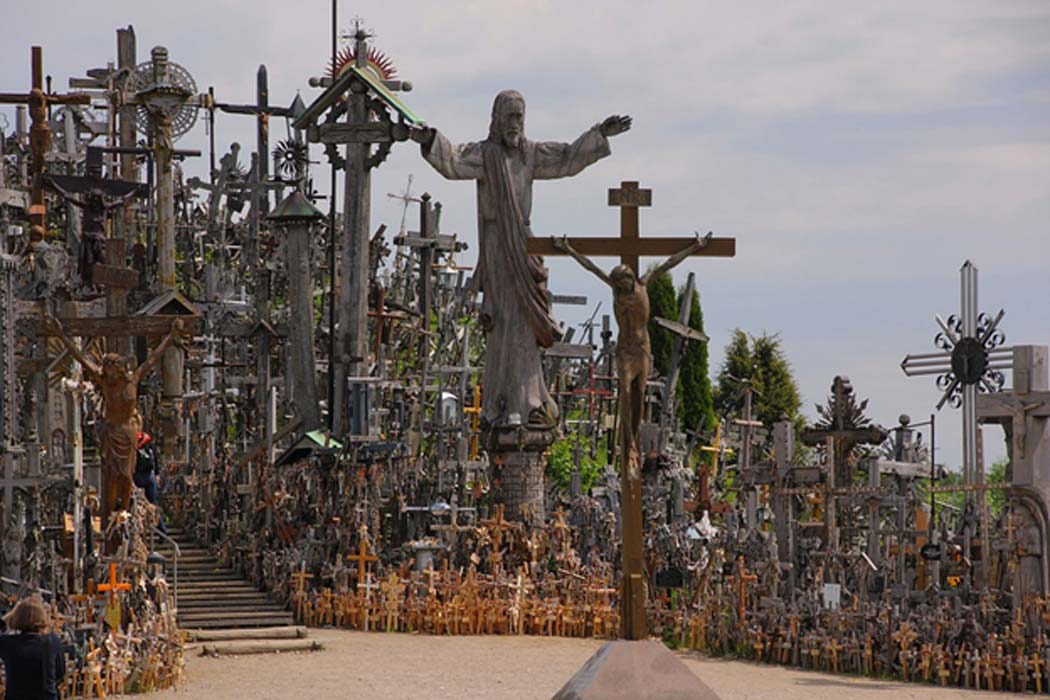Hill of Crosses: A Hundred Thousand Times Lithuania Has Stood Up
Estimates suggest as many as a hundred thousand crosses currently stand on The Hill of Crosses in Lithuania. Marking the loss of rebels who fought against outsider rule, the hill was torn apart by authorities, but built back up by resilient locals. It could be seen as not only a sacred space, but also a place of Lithuanian pride.
The Hill of Crosses (known also as the Jurgaiciai Mound) is a site located in the northern part of Lithuania, about 12 km (7.46 miles) to the north of Šiauliai (the fourth largest city in Lithuania), near the village of Jurgaičiai. Since Lithuania’s independence from Russia during the beginning of the 20th century, the Hill of Crosses has been a pilgrimage site. Although this sacred site has been visited by countless pilgrims over the decades, its status was further enhanced in 1993 following a visit by Pope John Paul II.

View of the numerous crosses on the hill. (Diego Delso/CC BY SA 3.0)
The First Crosses on the Hill of Crosses
The first crosses on the Hill of Crosses are believed to have been erected shortly after the November Uprising, which lasted from 1830 to 1831. During this conflict, Lithuania fought against the Russian Empire in an attempt to gain its independence. It has been claimed that after crushing this rebellion, the victorious Russians prohibited the dead rebels from being properly honored by their loved ones.
- The Encoded Crusader Sword: Can You Solve the Cryptic Code?
- What is in that Reliquary? Trying to Find the True Cross
- Mass suicide at Pilenai: Lithuanian Defenders Choose Death over Enslavement
Because of this, the family and friends of these rebels began erecting crosses on the Hill of Crosses. Be that as it may, the earliest references to the Hill of Crosses in written sources can only be traced back to around 1850.
Another rebellion against the Russians, known as the January Uprising, began in 1863, and ended in the following year. Though the rebels were once more unsuccessful in their struggle for independence, there was a surge in the erection of crosses on the Hill of Crosses. One of the reasons for this is the decision by the Russian authorities to ban the setting up of crosses not only by the side of roads, but also in cemeteries.

"Polonia (Poland), 1863", by Jan Matejko, 1864, National Museum, Kraków. (Public Domain) Pictured is the aftermath of the failed January 1863 Uprising. Captives await transportation to Siberia. Russian officers and soldiers supervise a blacksmith placing shackles on a woman (Polonia). The blonde girl next to her represents Lithuania.
Therefore, the Lithuanians decided to install crosses on the Hill of Crosses. Even more crosses were placed on the hill towards the end of the 19th century. Believers say that an apparition of the Virgin Mary and the child Jesus encouraged people to install crosses on this holy mound.
Forbidden Place
1940 saw the beginning of Lithuania’s occupation by the Soviet Union. The Soviets were removed from the country by Nazi Germany in the following year, though they returned in 1944 and occupied the Lithuania until 1991. During the Soviet era, the setting up of crosses was prohibited, and the Hill of Crosses became a forbidden place, as it was regarded as an opposition to Soviet ideology.
In 1961, the crosses on the hill were destroyed by the authorities. The wooden ones were burned, the metal ones melted and reused as scrap metal, and the stone and concrete ones crushed and used for road construction. This act of destruction not only failed to crush the spirit of the Lithuanians, but it further strengthened their resolve, as they began to rebuild their sacred space on the hill.

Kryžių kalnas – Hill of Crosses. (Mindaugas Macaitis/CC BY SA 4.0)
In the following decades, the Soviet authorities tried to destroy the Hill of Crosses. Some of the tactics were direct. Between 1973 and 1975, for example, about half a thousand crosses were destroyed each year. Subtle tactics were also employed. As an example, crosses were destroyed supposedly since they had no ‘artistic value’, and pilgrims were forbidden to visit the site due to certain ‘epidemics’. Yet, these actions were to no avail, as crosses would be secretly erected by believers at night.
- The Annals of Quedlinburg: Rare Example of Female Scholarship in Medieval Europe
- Yotvingians – Mighty Warriors of the Baltic Sea
- The Double-Headed Eagle: An Everlasting Symbol of Power
A Symbol of Lithuania
With the collapse of the Soviet Union in 1991, the persecution stopped, and the Hill of Crosses became a symbol of Lithuania. On September 7, 1993, the site was visited by Pope John Paul II. This visit by the head of the Roman Catholic Church made the location even more famous on the international stage.

View of the Lithuanian Hill of Crosses. (CC0)
Additionally, when the pontiff visited the Franciscan monastery at Mount Verna in Italy in 1994, he encouraged the order to build a monastery by the Hill of Crosses. This was eventually realized when a Franciscan monastery was consecrated there in 2000. Today, pilgrims continue to visit the Hill of Crosses, where about a hundred thousand crosses (and counting) have been set up over the decades by pilgrims who visited the site.
Top Image: A view of the Hill of Crosses. Source: CC0
By Wu Mingren
References
Catholic Internet Service, 2001. Hill of Crosses. [Online]
Available at: http://www.lcn.lt/en/bl/sventoves/kryziuk/
Gerulaityte, E., 2017. Lithuania's Miraculous Hill of 100,000 Crosses. [Online]
Available at: http://www.bbc.com/travel/story/20171026-lithuanias-miraculous-hill-of-100000-crosses
Gray, M., 2017. Hill of Crosses. [Online]
Available at: https://sacredsites.com/europe/lithuania/hill_of_crosses.html
Lithuanian State Department of Tourism, 2017. Hill of Crosses. [Online]
Available at: http://www.lithuania.travel/en-gb/attractions/hill-of-crosses/17171
Lonely Planet, 2017. Hill of Crosses. [Online]
Available at: https://www.lonelyplanet.com/lithuania/siauliai/attractions/hill-of-crosses/a/poi-sig/1085557/360110
O'Connor, W., 2015. Lithuania’s Amazing Hill of Crosses. [Online]
Available at: https://www.thedailybeast.com/lithuanias-amazing-hill-of-crosses
www.hillofcrosses.com, 2018. Hill of Crosses. Visit Popular Places in Lithuania. [Online]
Available at: http://www.hillofcrosses.com/



















